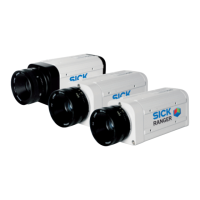Reference Manual Chapter 3
Ranger E/D
©SICK AG • Advanced Industrial Sensors • www.sick.com • All rights reserved 19
Mounting Rangers and Lightings
3 Mounting Rangers and Lightings
Choosing the right way of mounting the Ranger and illuminating the objects to be meas-
ured is often crucial for the result of the measurement. Which method to use depends on
a number of factors, for example:
What is going to be measured (range, gloss, grayscale, scatter, etc.)
Characteristics of the surface of the objects (glossy, matte, transparent)
Variations in the shape of the objects (flat or varying height)
Requirements on resolution in the measurement results
Measuring with the Ranger means measuring light that is reflected by objects, and from
these measurement draw conclusions of certain properties of the objects.
For a machine vision application to be efficient and robust, it is therefore important to
measure the right type of light.
Reflections
An illuminated object reflects the light in different directions. On glossy surfaces, all light is
reflected with the same angle as the incoming light, measured from the normal of the
surface. This is called the specular or direct reflection.
Matte surfaces reflect the light in many different directions. Light reflected in any other
direction than the specular reflection is called diffuse reflection.
Light that is not reflected is absorbed by or transmitted through the object. Objects absorb
light with different wavelengths differently. This can for instance be used for measuring
color or IR properties of object.
The amount of light that is absorbed usually decreases as the incoming light becomes
parallel with the surface. For certain angles, almost all light will be reflected regardless of
wavelength. This phenomenon is used when measuring gloss, which can be used for
example for detecting surface scratches (see the example on page 26).
On some materials, the light may also penetrate the surface and travel into the object, and
then emerges out of the object again some distance away from where it entered. If such a
surface is illuminated for example with a laser, it appears as if the object “glows” around
the laser spot. This phenomenon is used when measuring scatter. The amount and direc-
tion of the scattered light depends on the material of the object.
Figure 3.1 – Direct and diffuse reflections on opaque and semi-transparent objects.
The Ranger measures one cross-section of the object at a time. The most useful illumina-
tion for this type of measurements is usually a line light, such as a line-projecting laser or a
bar light.
Specular reflection
Diffuse reflections
Scattered light
bsorbed light Transmitted light

